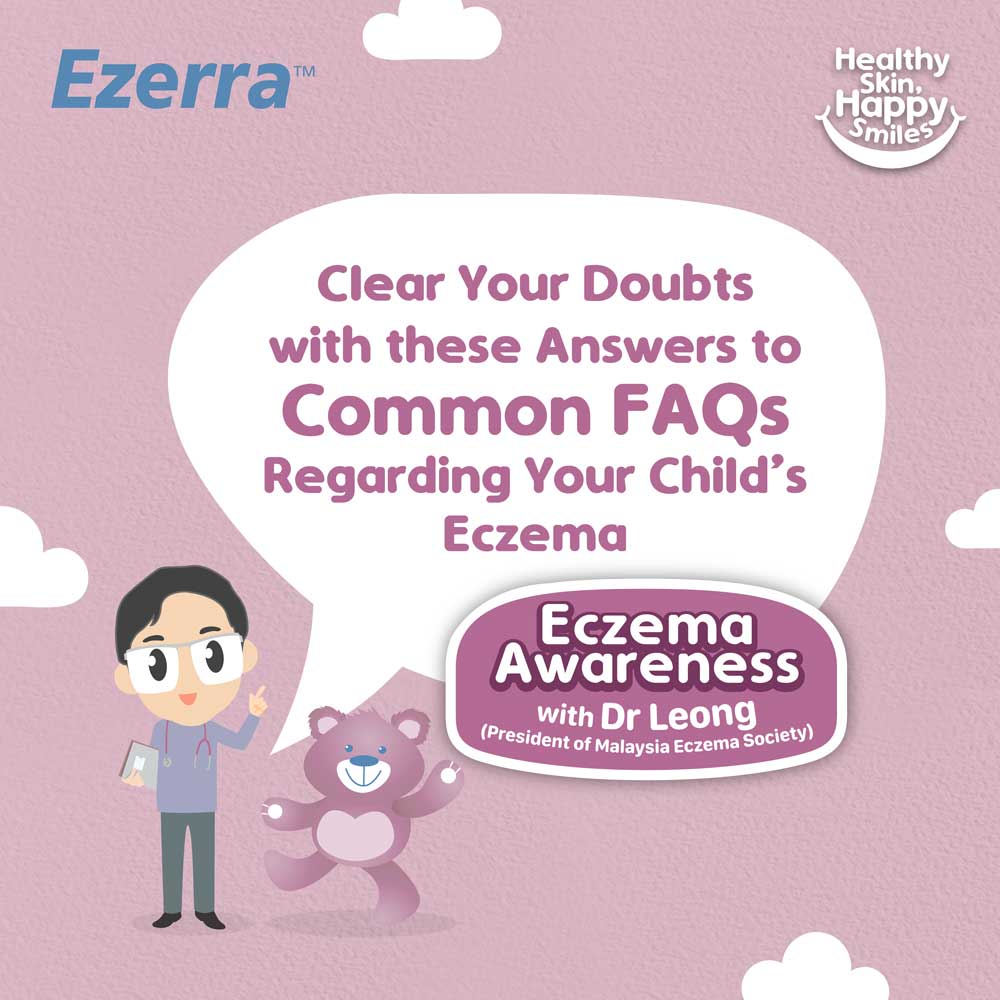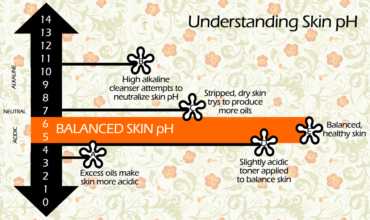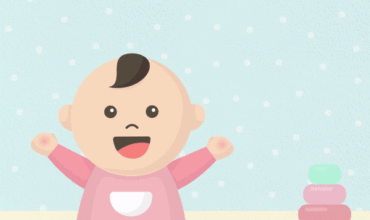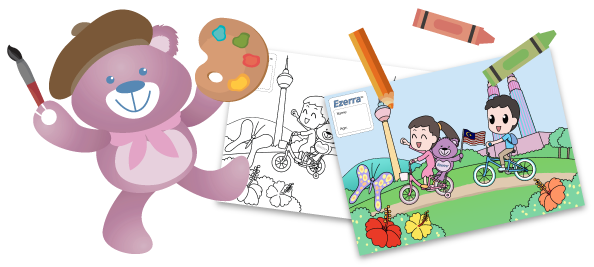About Your Child’s Eczema: FAQs & Answers
There’s always more to learn about your child’s atopic dermatitis as there is no single modded answer to understanding this skin condition. Here are some common FAQs parents usually ask regarding their child’s eczema.
How do I manage my child’s atopic eczema? Hit hard and aggressively for a cure?
To manage children with atopic dermatitis, first of all we have to understand the long-term natural cause of the disease. So in the case of atopic dermatitis, most of us are well aware that this skin condition is not an acute condition. In fact, it is a chronic relapsing inflammatory condition that takes months to years before they go into long-term remission. In this case, our primary aim is not an immediate cure within 2-4 weeks, but it is to flatten the curve, to get an early identification of any minor flare, act promptly and to stop it efficiently. To achieve this, we need 3 groups of treatment modalities;
- Medications
The first group of treatment modality is medications like creams, oral medications, tablets and injectables. Most patients with mild to moderate dermatitis require a lot of moisturisers, a little bit of steroids and a little bit of non-steroidal cream over the steroid sensitive areas. Occasionally, they do need antibiotics if the eczema gets a secondary infection. On the other hand, those with moderate to severe atopic dermatitis may require a form of oral or injectable treatment.
- Knowledge
The second group of treatment modality is in the form of knowledge. All caregivers of atopic dermatitis patients should attend an educational and empowerment program. Throughout the program, we will empower them with the knowledge on how to identify early eczema, how to act promptly at home to stop the flare and how to recognise the environmental factors that may induce the flare, elaborate on what is eczema and actively debunk the myths and fallacies pertaining to eczema. This is important because this could be one of the major factors for poor compliance and poor treatment response.
- Psychological support
Lastly, the third group of treatment modality is psychological support and tender loving care. This is very crucial especially for teenagers as although they are physically stronger, they are more psychologically fragile. They may end up with anxiety, depression and lack of confidence.
Without early detection and psychological support, they may also end up with poor compliance and poor treatment response.
How to manage dry skin among children with atopic eczema?
To many caregivers, as their baby develops atopic dermatitis, they often notice that the skin gets dry and scaly. As we all know, among the children with eczema, the three main features are dryness, itchiness and inflammation. These three features do not act independently. In fact, they are mutually reinforcing, creating a chain reaction and once they achieve a certain momentum, they produce a vicious cycle of dryness, itch and inflammation-infection. In order to stop this cycle, it is not about tackling one of these three components. In fact, you have to tackle all three simultaneously, with or without infections. So, how do we actually manage this dryness and what are the benefits of doing so? The answer is, by improving skin hydration, the itchiness and inflammation will be minimised and at the same time, it has a steroid sparing effect. In other words, by using an adequate and routined moisturiser, the itchiness will be reduced and the amount of steroid needed will be lower because of this improvement. On the other hand, please do not just rely on moisturisers.
By understanding this cycle, the key treatment strategy is to break this cycle by targeting these three components simultaneously. In other words, you need to use a lot of moisturiser, a little bit of steroid and a little bit of nonsteroidal anti-inflammatory product. By doing so, you may flatten the curve and maintain it with minimal fluctuations. So, how are we going to improve skin hydration? One of the easiest and most effective ways is to get an ideal moisturiser and empower your child to apply immediately after every shower, before bedtime, and also every time they are in an air-conditioned room where there is low humidity. One important thing to note is to not apply it immediately after sweating or onto weepy and irritated eczema skin.
Another important measure to practise is to use a gentle cleanser. Look for the ones that have 99.99% antibacterial property. This is because whatever you use on the skin, what we want to achieve is the balance between good and harmful bacteria. One more thing to keep in mind is that whenever you bring your child out for any sport activity, especially for swimming, make sure to keep it short and apply moisturiser after showering.
What are the ideal features of a moisturiser that is designed for atopic eczema?
One of the most frequently asked questions about moisturisers in the context of atopic eczema is “Which moisturiser in the market is considered the best?”. Personally, I do not think there is any single best answer to this question. The reason is because there are so many good and ideal moisturisers in the market that are formulated specially for atopic eczema.
Next, what are the essential features of an ideal moisturiser for atopic eczema? The very first thing to consider is whether or not the moisturiser contains both humectant and occlusive properties. Occlusive means it forms a thin layer of lipids over the dry scaly skin to prevent water evaporation. Meanwhile, exogenously, they provide humectant in the form of urea, glycerine, and Sodium Pyrrolidone Carboxylic Acid (PCA) to increase the water holding capacity of the skin. These dual actions may improve skin hydration and prevent water evaporation.
Other than that, an ideal moisturiser for atopic eczema patients should come in different formulations; either lotion, cream or ointment as there is no single formulation that is suitable for all weather conditions and skin types. For example, for a tropical country, if the child is exposed under the hot and humid weather, a lotion or a cream-based moisturiser is more suitable because the thick consistency of the ointment will make the skin become greasy. Therefore, an ointment is more suitable for a child who is always indoor as it has a longer lasting effect on the skin.
As we all know, eczema skin is dry, sensitive and easily irritated. Therefore, an ideal moisturiser for atopic eczema skin should also be hypoallergenic with minimal chemicals to lower the risk of irritation and allergic reaction. Another thing to consider is a more cost-effective skin care routine. What I normally advise the parents to do is to get a basic lotion for the whole body and use the more expensive and effective emollient over the hotspot areas.
Another feature of an ideal moisturiser for eczema skin is they need to have the ability to break the vicious cycle; dry, sensitive, itchy, and inflamed skin with or without secondary infection. So when you want to look for a moisturiser to help keep your child’s dry and irritated skin hydrated, look for these essential features that make up an ideal moisturiser for atopic eczema patients.
Is steroid cream safe on babies with atopic eczema?
If this question appears in a multiple choice form, then the answer is YES. If it is debatable, then the answer is a big fat YES and a soft little NO. It all depends on how you use it, how long you use it and on which part of the body it is used on. All medicines are poisonous if you do not use them properly, and all poisons are medicines if used at the right dosage and timing.
Therefore, to be able to use steroid cream safely, efficiently and confidently, you need to hold onto three basic principles. The first being the right attitude and knowledge. For your information, steroids are natural that even our body produces steroid cortisol every day, which is also known as stress hormone. Thus, this makes the steroid hormone or a steroid cream natural. Another important principle while using steroids is to choose the right class of steroid to handle the right degree of inflammation on the skin.
Besides, it is a good measure to write and plan a strategy. We know that atopic eczema is a relapsing chronic skin condition, therefore, you cannot rely on steroids alone. A combination strategy is needed. The formula goes moisturiser + steroid + Calcineurin Inhibitor
I hope these answers to the FAQs may help you clear any doubt that lingers in your mind. Thank you for taking some time to read and I hope this blog article helps you understand your child’s atopic dermatitis skin condition better.
Prepared by:
Dr Leong Kin Fon
President of Malaysia Eczema Society
Disclaimer:
The content of this article is for educational purposes only. Seek the advice of your medical provider regarding any questions or concerns you have about your baby’s specific skin condition.
P/S: We are proud to present our Childhood Eczema Awareness series featuring Dr. Leong, the President of Malaysia Eczema Society! Watch the complete series at our YouTube channel to find out more about the rising prevalence of childhood eczema in Malaysia!









